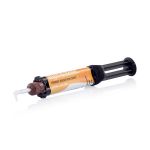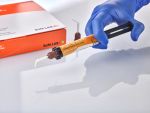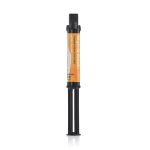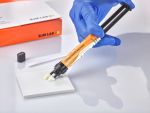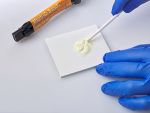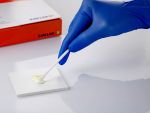- A multi-purpose, dual-cure, radiopaque, permanent adhesive resin cement.
- ISO 4049 classification: Type 2, Class 3.
- Radiopacity value above 2.5mm Aluminium. (Radiopacity is defined as the ability of a material to be visible in x-ray photographs.)
- Forms ideal bond with metal alloys, porcelain, ceramic, dentin, enamel.
- Has a chemical affinity for metal.
- A dual-cure cement – it has a self curing mechanism which can also be light cured for an immediate set and extra strength at the margins.
- Light curing High-Q-Bond gives your restorations immediate stability and easy clean up of excess material.
- Features high retention and total margin integrity.
- Marketed since 2000 with no changes in formula. No complaints of any health-related or chemical performance issues were received.
Technical Data
Compressive strength: > 150 MPa
Flexural strength: > 100 MPa
Hardness by Shore A: ~80
Water sorption: ≤ 40 μg/mm3
Solubility: ≤ 7.5 μg/mm3
Shear bond strength to etched enamel: > 10 MPa
Shear bond strength to etched dentin: > 5 MPa
Shear bond strength to metal alloy: > 10 MPa
Shear bond strength to pretreated porcelain / ceramic surface (Zirconia): > 5 MPa
Film thickness: >50
Radiopacity: >100 % Al
Working time (in ambient light and temperature): > 90 seconds, in the 1.5 - 3.5 min interval
Setting time (in oral temperature): < 10 minutes, in the 2.5 - 4.5 min interval
Light curing time: 10 – 20 seconds
Compatible with LED: Yes
Compatible with halogen light: Yes
Compatible with Plasma ark light lamp: Yes
Shelf life: 2 Years
Compatible with Plasma ark light lamp: Yes
Compatible with LED: Yes
Shelf life: 2 Years
Instructions for Use
Scientific Literature
- The role of anaerobic accelerator in dental adhesives, I. Eppelbaum, H. Dodiuk, S. Kenig, B. Zalsman, A. Valdman and R. Pilo, J. Adhesion Sci. Technol, Volume 10, No.10, pp. 1075-1087 (1996).
- An advanced multipurpose dental adhesive system, I. Eppelbaum, H. Dodiuk, S. Kenig, B. Zalsman and A. Valdman, J. Adhesion Sci. Technol., Volume 9, No. 10, pp. 1357-1368 (1995).
- Gingival response to a new multipurpose dental adhesive: A histologic study in dogs, M. Redlich, D. Harari and S. Shoshan, The Journal of Prosthetic Dentistry, Volume 76, No. 4, pp. 379-385 (1996).
- Long-term durability of adhesive systems bonded to fresh amalgam, R. Pilo, T. Brosh, E. Shapinko and H. Dodiuk, The Journal of Prosthetic Dentistry, Volume 76, No. 4, pp. 431-436 (1996).
- A Laboratory Evaluation of Adhesive Resin Cement, Prof. M. Latta, Creighton University School of Dentistry, Omaha, Nebraska, 1997.
- New dual cure multipurpose adhesive resin cement, B. Zalsman, H. Dodiuk, A. Valdman and I. Eppelbaum, 76th General Session of IADR, 1998.
- Advanced metal free endodontic post system: a case report, K. Krasteva, Varna, Bulgaria, 1998.
- Comparative Evaluation of Bond Strengths of Panavia and Primabond 97 to posts cemented in the root dentin: final report, D. H. Pashley, School of Dentistry, Medical College of Georgia, 1998.
- Evaluation of four adhesive systems on a metallic structure, not noble for dental porcelain, A. Paz, 1999.
- A new multipurpose dental adhesive for orthodontic use: an in-vitro bond strength study, D. Harari, E. Aunni, I. Gillis and M. Redlich, American Journal of Orthodontics and Dentofacial Orthopedics, September 2000.
- Research report: Shear Bond Strength of Total Etch Two-Step Primer / Adhesive Systems with Dual and Chemical-Cure Resin Cements, M. Pasciuta, D. Cobb, College of Dentistry, Iowa, 2001.
- Laboratory Evaluation of 24 hours Shear Bond Strength of Ceramic to Dentin Using Three Cement Systems, Prof. M. Latta, Creighton University School of Dentistry, Omaha, Nebraska, 2006.
- Tooth restoration by ceramic inlays: a tutorial, Ryakhovsky, A. Karapetyan, Moscow, 2008.
- Testing of crowns retention to various abutments utilizing different cements, K. Lizenboim, A. Suvorov, B. Zalsman, and I. Suvorov, PEF-IADR 2008.
- Cements adhesion to ceramic as a function of surface treatment, K. Lizenboim, I. Suvorov, B. Zalsman, H. Dodiuk, Program Number 402, PER-IADR Congress, Dubrovnik, Croatia, 2014.
SDS
100050AM High-Q-Bond Automix
1 Automix Syringe 5ml (8g) of High-Q-Bond
10 Automix Syringe Mix Tips
5 Intraoral Angular Tips, Size Fine
5 Intraoral Angular Tips, Size Long XX-Fine
100050HM High-Q-Bond Hand Mix (DMA)
1 Automix Syringe 5ml (8g) of High-Q-Bond
1 Detachable Manual Adapter
1 Mixing Pad

